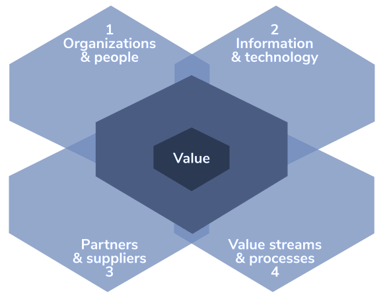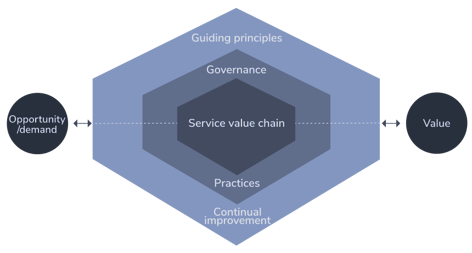The change to remote work has forced Information Technology (IT) teams to quickly and efficiently serve their customers. Due to this change, many people talk about using ITSM processes or ITIL strategies to help their teams.
ITSM vs. ITIL
Looking at ITSM and ITIL can get confusing. Are they the same? Or completely different? What does an IT team implementing these practices look like? To answer these questions, we first have to understand the differences between ITSM and ITIL.
What is ITSM?
Atlassian defines Information Technology Service Management (ITSM) as a way IT teams manage the end-to-end delivery of IT services to customers. This includes a defined set of processes to design, create, deliver, and support IT services.
I think of ITSM simply as a set of tools you can use to improve your IT team. Just like you would use a handsaw to cut a piece of wood or a screwdriver and a screw to connect two pieces of wood together, you have to think about what you would like to accomplish with your IT team and which tool would be best for the job.
ITSM processes focus on your customers' needs and services rather than the IT systems behind the scenes. These processes, when implemented properly, can help cross-department collaboration, increase control and governance, deliver and maximize asset efficiency, provide better and quicker customer support, and reduce costs across the organization. Just look at how this global leader in electronic payments saved $4 million by implementing ITSM best practices.
What are some of these magical processes? Glad you asked!
-
Service Request Management
Any incoming inquiries asking for access to applications, software licenses, password resets, or new hardware are classified as Service Requests. These requests are often recurring and can be made into simple, duplicable procedures. These repeatable procedures will help IT teams provide quick service for recurring requests. Applying well-designed practices to your Jira Service Management application can streamline the process for an organization's customer to create Service Requests and for internal IT teams to act on the Service Requests.
-
Knowledge Management
The process of making, sharing, utilizing, and managing data of an organization to attain its business objectives can all be a part of Knowledge Management. Creating a Knowledge Base (KB) for IT teams to create content is crucial for teams to learn from the past and maximize productivity. Having a collaborative workspace, such as Confluence, for all teams to work within can help create one source of truth of information. KB articles can also be shared with your customers through the Jira Service Management portal to help resolve common or simple Service Request without having to contact the IT Team.
-
IT Asset Management (ITAM)
IT Asset Management (also known as ITAM) helps ensure valuable company resources are accounted for, deployed, maintained, upgraded, or properly disposed of. Since assets have a relatively short lifecycle, it's important to make the best use of all that are available. Integrating tools such as Insight with your Jira instance can help track all valuable assets throughout your organization conveniently within Jira issues in real-time.
-
Incident Management
Any process that is responding to an unplanned event or downtime will fall under the Incident Management bucket. The only goal of Incident Management is to make sure that problematic services are brought back to their original operational status in the shortest time possible. For any incident to be quickly resolved, the original reporter has to be able to quickly communicate with the proper IT team asking for help and the IT team must be able to easily communicate back with the reporter to gather any relevant information needed to solve the problem. Jira Service Management can help make this crucial communication effortless.
-
Problem Management
Taking lessons learned from an incident and determining the root cause of the problem so that future incidents can be prevented or, at minimum, limiting downtime is the basis of Problem Management. Once a root cause analysis is performed on an incident and documented within your Confluence instance, the impact of future incidents can be reduced.
-
Change Management
Change Management can be used to control and understand the impact of changes being made to all IT Infrastructure. The Change Advisory Board (CAB), a group of individuals tasked with evaluating, scheduling, and validating a change, can be leveraged to better maintain and ensure the stability of your IT Infrastructure. By taking advantage of Jira, employees can easily suggest changes and the CAB will be able to review the proposed changes, approving and scheduling the change as they see fit.
To see these processes in action, let's consider a tangible example that will help bring it all together:
"Austin Snow" is a new employee at your company. As part of the onboarding process, they will need a brand new laptop. As their manager, you submit a Service Request to your IT team through the Jira Service Management Help Center. An agent in your accounting department is then assigned to this task. Using information from a KB article that has been built out in a Confluence page, the agent can see that they are supposed to put in a purchase order for the new device. From the Confluence page, the agent also knows to add this new asset in Insight and assign ownership to Austin.
Once the laptop is delivered and Austin tries to access an application and finds that they get a 404 error message. Austin reaches out to the IT team through the Help Center to create an incident with them. The IT team then proceeds to investigate this issue. They can find the root cause of the problem and fix it. Using the lessons learned from this incident, the IT team performs a root cause analysis (RCA) for the problem. As a result of the RCA, it is found that a change to the organizations' infrastructure can help prevent this problem in the future. The IT proposed the change to the Change Advisory Board (CAB) who then investigates the impact of this change, weighs pros and cons and schedules an outage window to perform this change.
As can be seen in this example, ITSM processes can help quickly fulfill requests, transfer knowledge, keep track of assets, respond to problems, identify the cause of a problem, and implement any changes needed to prevent problems in the future.
What is ITIL?
Information Technology Infrastructure Library (ITIL) is a set of best practices designed to support a company's IT operations. ITIL was introduced in the late 20th century as a series of books by a government agency in Great Britain in an attempt to help the British Government provide a better quality of IT service at a lower cost. ITIL v2 condensed all of the content in the early 2000s into nine publications. These two older versions are seldom used; most organizations currently implement ITIL v3 or ITIL 4.
ITIL 4
Most recently, ITIL 4 has incorporated the latest trends in technology and service management to support organizations as they enhance their operations and align with evolving business needs. ITIL 4 consists of two main components; the four dimensions model and the service value system (SVS).

Source: AXELOS, “ITIL Foundation: ITIL 4 Edition” (2019)
The four dimensions model lays out four key areas to consider to ensure a holistic approach to service management. These four dimensions are Organizations and People, Information and Technology, Partners and Suppliers, and Value Streams and Processes. The four dimensions have to work together to help ensure that any Product or Service provided to the customer is able to provide value in an effective and efficient manner.
For example, in the above Austin Snow use case, the Organizations & People would be the HR Team performing the onboarding, the IT team helping deliver the laptop, the Support team handling the outage, and Austin Snow themself. The Information & Technology would be all the tools, Jira Service Management, Insight, etc. that were used to help Austin. The Partners & Suppliers would consist of the internal IT team in charge of the service request and incident management or any other external team that was leveraged to deliver the request or fix the incident. Finally, the Value Streams & Processes would consist of any well-defined procedures that were used to help deliver the service to Austin.

Source: AXELOS, “ITIL Foundation: ITIL 4 Edition” (2019)
The service value system lays out how all the components of an organization have to work together to provide maximum value. To accomplish this, 5 main elements are used to produce Value from an Opportunity or Demand; Guiding Principles, Governance, Service Value Chain, Practices, and Continual Improvement.
Guiding Principles help define how an organization will respond in all circumstances. These principles should be considered when making any decisions. Governance defines how an organization is directed and controlled and always stems from Guiding Principles. The Service Value Chain is a set of inter-united processes used to deliver a product or service to a customer. Practices are resources to help perform work. Continual Improvement is how the process can be improved to help provide the most amount of Value to an organization. When all of the elements of the SVS are implemented and used properly, an organization will be able to capitalize on every Opportunity. The four dimensions must be considered with all elements of the SVS to ensure a great quality of service is provided to your customers.
How Are ITSM and ITIL Different?
Now that we have laid down a foundation for ITSM and ITIL concepts, let's discuss ITSM vs. ITIL.
These two concepts are not opposing ideas. ITIL is a framework of ITSM, meaning ITIL takes the concepts and values of ITSM and lays out a set of defined best practices that organizations can easily apply to their business to help improve IT services. In other words, ITSM processes describe the "what" while ITIL best practices describe the "how".
ITIL is not the only ITSM framework; frameworks or processes such as DevOps, Kaizen, Lean, and Six Sigma are also implemented by organizations. ITIL is the most popular ITSM framework to help improve IT service delivery.
Modernizing Your Business Operations
To summarize comparing ITSM vs. ITIL, ITSM is a defined set of processes to design, create, deliver, and support IT services. ITIL, a framework of ITSM best practices, can be used as a set of guidelines to quickly adopt ITSM principles into your organization.
Praecipio can help modernize your operations by extending service management capabilities to all teams in the organization. We’ve seen it all when it comes to poorly managed ESM, and our team of experts brings together your people, processes and technology to meet your business needs.
If you have more questions on ITSM vs. ITIL, contact us to learn how your organization can benefit from these powerful methodologies.

